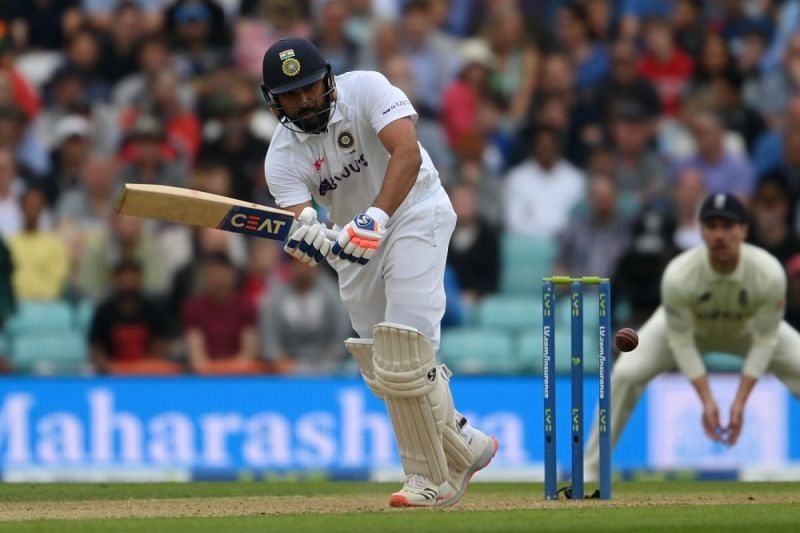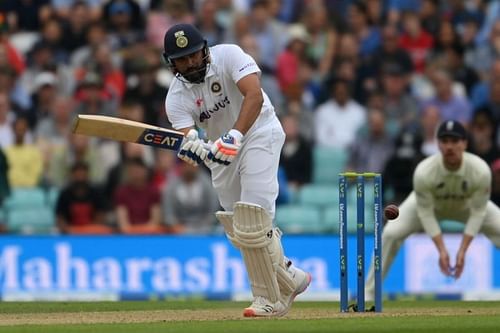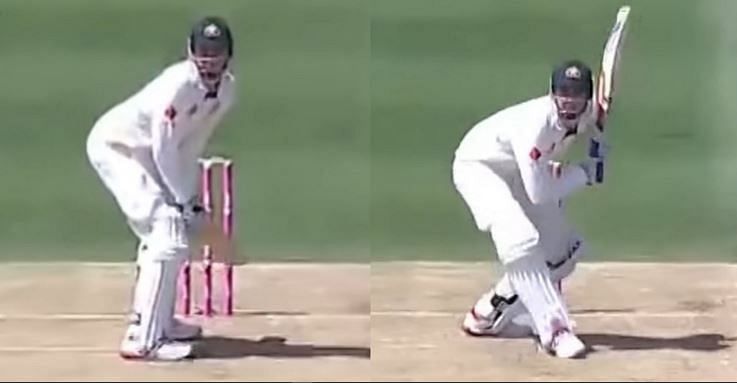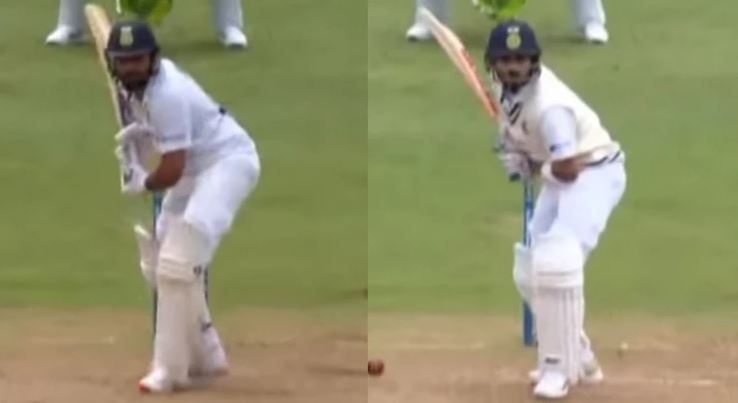
Rohit Sharma and the forward press

I've been trying to understand trigger movements for a while now, and nothing's been more difficult to comprehend than the forward press. The other triggers - the crouch, the back-and-across, the back foot adduction - aren't all that much of a problem because they are all double trigger movements.
You either move both your legs, or none at all, and if you're still insistent on using a single trigger movement, you do it with your back foot. Then there's Matt Renshaw, who used to do this:

This is not him setting up to drive. This is his trigger movement. Though there are limitations to gleaning this from the broadcast angle, it's reasonable to say judging from the amount of his back foot visible in the second frame that his forward press has taken him forward by an extraordinary amount.
It's not something that you see in cricket, and definitely not against quick bowlers. In fact, Renshaw has now reworked his technique.
There are multiple reasons for this. At its root, cricket is still played on only one leg. According to Nathan Leamon and Ben Jones' brilliant new book, 66% of batting in Test cricket occurs on the front foot. You might think this is a reflection of the lengths they're faced with, but it's not, even in the good lengths, where it's assumed that batters are faced with the quandary of switching backwards or front, 83% of balls are met with a stride forward.
And that's not all: Karthikeya Manchala tells me that front-foot strokes are 1.31 times as common as back-foot shots in the Indian Premier League (IPL). If two-thirds of the balls can be encountered on the front foot, it's better to set up to push forward.
This is a result of several things, including the fact that cricket is naturally supposed to be so. By definition, the laws of the game allow you to go back by only 1.22 meters (the distance between the stumps and the crease) whereas to go forward there is no such cap.
Of course, this is a conservative generalization that will go into the dump the moment a batter stands outside the crease, but it still stands that there's considerably more freedom to "use the depth of the crease" forward than back.

Then there's the physiological aspect of it. Playing on the back foot is hard, because it needs you to make a movement intrinsically uncomfortable to the human body. The first act in playing any shot is opening up your body so that the bat can see the ball (open it up by how much is the matter of intense discussion running on Twitter).
For a front-foot shot, this coincides with the transfer of weight onto your front foot, implying your front foot is in motion, so you open up the body by pointing the front toes in a straighter direction. For a back-foot shot you're transferring your weight on to your back foot, so you open the body by pointing the back toes in a straight direction.
The point is, both these movements are different kinds of rotation, physiologically. The front foot rotating anticlockwise is what's called an external rotation, and the back foot pivoting anticlockwise is an internal rotation. If you want to confine it in terms of just one leg, let's talk with respect to the right: Rotating your right leg anticlockwise gives you an internal rotation, rotating it clockwise is an external rotation.
The pickle here is that one of these is harder than the other. The triangular pelvic bone encloses the inside part of the leg closer to the knee joint, thereby decreasing the maximum range of movement possible towards the hips. If that's too much to ask for, just get on your feet and try rotating your right leg clockwise and anticlockwise. Which one is the easier movement?
At the heart of it, even if they pick up cues from a bowler's run up, even if they have practice and experience under their belts, batters are a species of sportspersons who are required to undertake a smorgasbord of actions in an Lilliputian moment. If for a given set of variables, one alternative is less comfortable than the other, they'll probably go with the more comfortable one, even if the less comfortable option averages 26.9 runs more than the other one.
Add to that the fact that foot movement for a back-foot shot occurs at vast range; the back toe could point anywhere between mid-on for the pull shot and third man for a cut, and it is with good reason that the front foot is the dominant foot in the Test game.
Then the forward press makes little sense, right? If its primary use is to set the stage for a back-foot stroke, that is nearly a redundant aspect of cricket.
By the time you've finished reading that, Rohit Sharma's probably plonked his left foot down once more. And in the time you've taken to read this article, he's scored an overseas hundred with it. Rohit has three kinds of trigger movements right now - the crouch, the back-and-across, and the forward press, and he switches between these in god-knows-why arbitrariness.
But if there's one thing we can glean from this, it's that the forward press can still be valuable if your intent for using it is not to concentrate your weight on the front foot, but to close down your front body to face the outswinger.
In his interview with Dinesh Karthik, Rohit spoke about opening up his stance ahead of the 2020-21 overseas cycle, but this was seemingly at odds with how he planted his front foot across in his trigger. It militates against the central need to keep an eye out for the inswinger, and makes the body more side-on.
However, Rohit has countered this using an intelligent repositioning of his back leg in the direction of cover; the ostensible Waterloo of Virat Kohli is Rohit's magnum opus. The difference is that Rohit's forward press closes off part of the body, effectively compensating for the openness of the front and back hips.

On the face of it, Rohit's Test career trajectory is a sinusoidal curve of promises and perishes that, like an airplane which exhausts its fuel every few seconds, has run off course for the majority of its flight but has found redemption in England.
But there's also a meticulous patchwork of technical changes on top of technical change, capped off with the adoption of a ragtag ingredient disposed off by other mortals that, if suboptimally used, can estrange the most popular shot type in cricket.
The forward press is ungainly, Rohit Sharma is not.